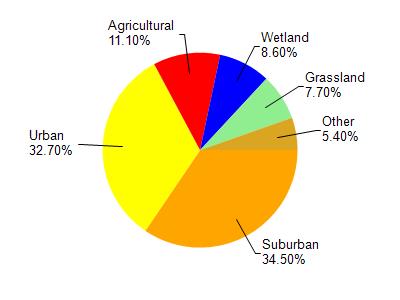Washington
No
No
No
Fish and Aquatic Life
Overview
Rockfield Quarry Pond is a quarry pond in Niagara limestone in the village limits of Rockfield. The limestone in this vicinity provides numerous flowing wells, and the quarry no doubt receives water from fissures in the rock formation. The water is highly alkaline, and green algae blooms are common throughout the summer. Presently the owner leases the quarry to a bait dealer who periodically harvests minnows. Private stocking of bullheads and panfish may have occurred. Public access is not available, and swimming is discouraged since the banks are very steep and the mean depth over 18 feet.
Source: 1963, Surface Water Resources of Washington County Rockfield Quarry Pond - T9N, R20E, Sec. 9, Surface Acres = 2.6, S.D.F. = 1.20, Maximum Depth = 27 feet.
Date 1963
Author Aquatic Biologist
Condition
Wisconsin has over 84,000 miles of streams, 15,000 lakes and milllions of acres of wetlands. Assessing the condition of this vast amount of water is challenging. The state's water monitoring program uses a media-based, cross-program approach to analyze water condition. An updated monitoring strategy (2015-2020) is now available. Compliance with Clean Water Act fishable, swimmable standards are located in the Executive Summary of Water Condition in 2018. See also the 'monitoring and projects' tab.
Reports
Recommendations
Lake Classification
Phase 3 of Lake Classification Project. Public Hearing and Ordinance revision adoption for the lakes in Washington County. Dissemination of proposed ordinance changes to the other local units of government. Enforcement of revised zoning provisions related to shorelands, wetlands, and floodlands through current channels. Information to public of changes in Washington County codes by meetings, publicity, pamphlets, and brochures.
Lake Classification
Through this project Washington County will develop a waterbody classification system; review and revise shoreland-wetland and floodplain ordinances; and refine the ordinance provisions governing shorelands, wetlands and floodlands, incorporating the waterbody classification into them.
Management Goals
Wisconsin's Water Quality Standards provide qualitative and quantitative goals for waters that are protective of Fishable, Swimmable conditions [Learn more]. Waters that do not meet water quality standards are considered impaired and restoration actions are planned and carried out until the water is once again fishable and swimmable
Management goals can include creation or implementation of a Total Maximum Daily Load analysis, a Nine Key Element Plan, or other restoration work, education and outreach and more. If specific recommendations exist for this water, they will be displayed below online.
Monitoring
Monitoring the condition of a river, stream, or lake includes gathering physical, chemical, biological, and habitat data. Comprehensive studies often gather all these parameters in great detail, while lighter assessment events will involve sampling physical, chemical and biological data such as macroinvertebrates. Aquatic macroinvertebrates and fish communities integrate watershed or catchment condition, providing great insight into overall ecosystem health. Chemical and habitat parameters tell researchers more about human induced problems including contaminated runoff, point source dischargers, or habitat issues that foster or limit the potential of aquatic communities to thrive in a given area. Wisconsin's Water Monitoring Strategy was recenty updated.
Grants and Management Projects
Monitoring Projects
| WBIC | Official Waterbody Name | Station ID | Station Name | Earliest Fieldwork Date | Latest Fieldwork Date | View Station | View Data |
|---|
|
|

Watershed Characteristics
Rockfield Quarry Pond is located in the Menomonee River watershed which is 136.12 mi². Land use in the watershed is primarily suburban (34.50%), urban (32.70%) and a mix of agricultural (11.10%) and other uses (21.70%). This watershed has 174.17 stream miles, 352.64 lake acres and 5,967.40 wetland acres.
Nonpoint Source Characteristics
This watershed is ranked High for runoff impacts on streams, High for runoff impacts on lakes and High for runoff impacts on groundwater and therefore has an overall rank of High. This value can be used in ranking the watershed or individual waterbodies for grant funding under state and county programs.However, all waters are affected by diffuse pollutant sources regardless of initial water quality. Applications for specific runoff projects under state or county grant programs may be pursued. For more information, go to surface water program grants.